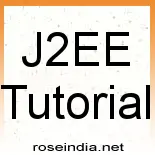This section is for those who want to write the fast, secure and reliable distributed transactional applications for the enterprise, e-commerce, and enterprises applications. In this section we will discuss what is J2EE, features of J2EE applications, J2EE tiered applications, Web Container, J2EE versions etc.

In this section we will read about Java J2EE.
This section is for those who want to write the fast, secure and reliable distributed transactional applications for the enterprise, e-commerce, and enterprises applications. In this section we will discuss what is J2EE, features of J2EE applications, J2EE tiered applications, Web Container, J2EE versions etc.
J2EE is the most popular for developing applications and the demand of J2EE professionals are very high in the market. Java EE is a Java computing platform that provides API and the run time environment to develop and run an application these applications can be network based applications, web services, enterprise software. Using Java EE a developer can develop applications that can be multi-tiered, scalable, large-scale application, reliable and secure network applications. Enterprise applications can be developed for almost all types of organizations whether they are small, medium or large.
Requirements To Develop Java J2EE based application
A developer who wants to develop a web based application in Java he/she should have need to :
- Familiar with Java Programming Language .
- JDK ( Java Development Kit)
- Modern Web Browser (should be installed in the system).
- Java based Web Server/Application Server.
- Java text editor.
Features of Java EE Applications
Java EE applications have various of features that makes it powerful these are as follows :
- Enterprise applications are secure.
- Enterprise applications are reliable.
- Enterprise applications are scalabel.
J2EE Tiered Applications
Java EE allows to develop the multi-tiered applications, in multi-tiered applications different functionality of an application functions on different tiers ( a separate functional area). In Java multi-tiered applications have generally the following tiers, client, middle, and data tier. Each tier is responsible for functioning different functionality.
Client Tier:
In a client tier a client makes a request to a server which is running on different machine. In this process request made by client is processed on server and returns the appropriate response back to the client. Request can be made from a browser, a standalone application, or other servers running on different machine from the Java EE server.
Web Tier:
Web tier lies as a component that manages clients and business tier interaction. In web tier following Java EE technologies can be used :
- Servlets
- JavaServer Pages (JSP)
- JavaServer Pages Standard Tag Library
- Expression Language
- JavaServer Faces technology
- JavaServer Faces Facelets technology
- JavaBeans Components
Business Tier:
Business tier allows for the business logic of an application. In business tier following Java EE technologies can be used :
- Enterprise JavaBeans (enterprise bean) components
- JAX-RS RESTful web services
- JAX-WS web service endpoints
- Java Persistence API entities
- Java EE managed beans
Enterprise Information Systems(EIS) Tier:
In EIS tier generally resources are locates on separate machine than the Java EE server these resources can be accessed by the business tier components. In EIS tier following Java EE technologies can be used:
- Java Database Connectivity API (JDBC)
- Java Persistence API
- Java EE Connector Architecture
- Java Transaction API (JTA)
Web Container
A web container controls the web components, it manages its life cycle, dispatches requests to application components, current request information etc. Following can be a web component Servlet, JSF facelets page, JSP page etc.
J2EE versions
Major versions of J2EE are as follows :
- Java EE 6 (Latest version at the time of writing this tutorial)
- Java EE 5
- J2EE 1.4
- J2EE 1.3
- J2EE 1.2
